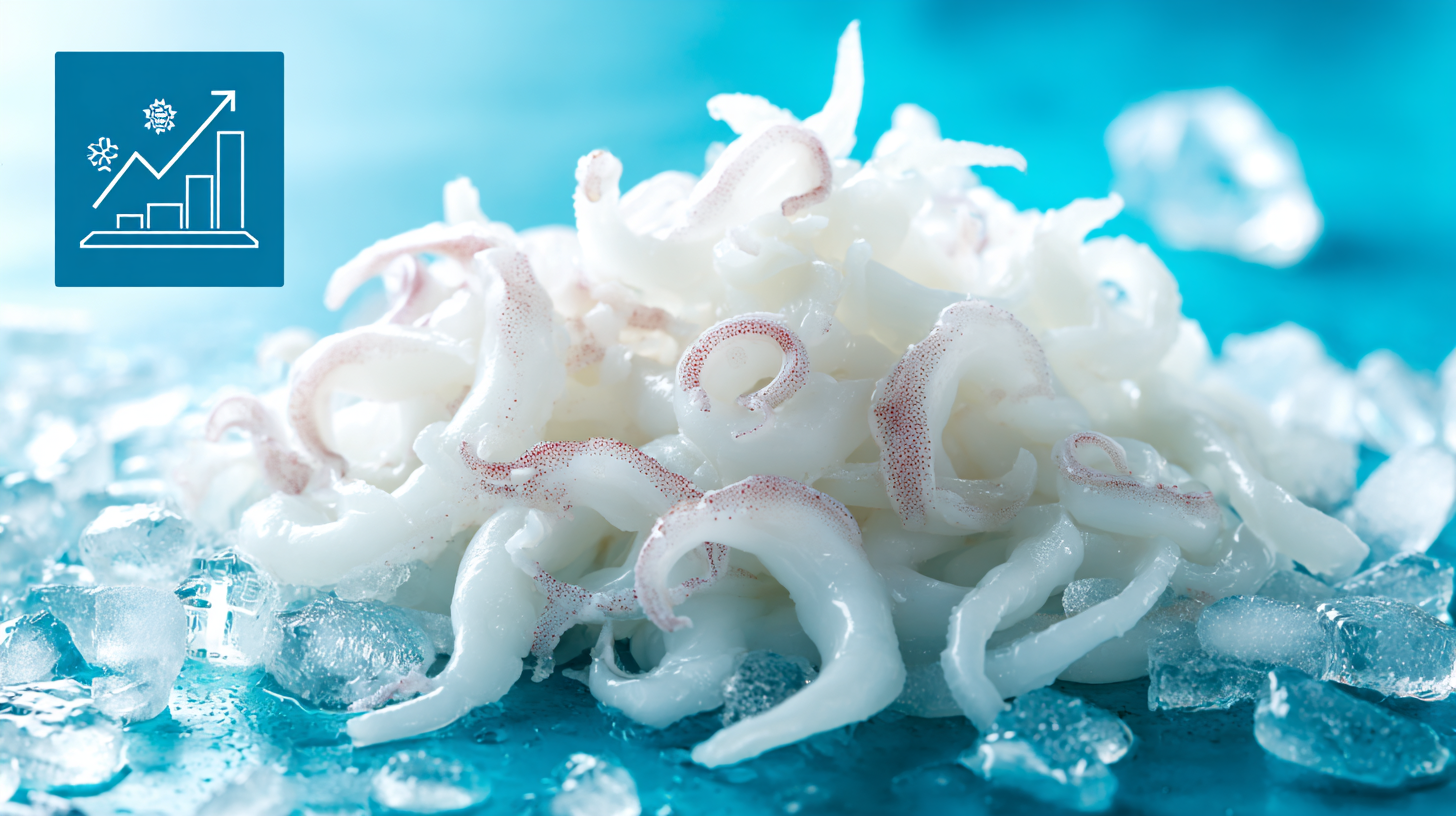The global market for Frozen Squid Roe is poised for remarkable growth as we approach 2025. According to a recent report by Market Research Future, the seafood segment is projected to witness a compound annual growth rate (CAGR) of approximately 4.5% from 2022 to 2025, largely driven by increasing consumer preferences for protein-rich dietary options and the rising popularity of Asian cuisines worldwide. Frozen Squid Roe, known for its rich flavor and versatility in culinary applications, is set to capitalize on these trends. Additionally, a comprehensive analysis by Global Industry Analysts Inc. indicates that the demand for premium frozen seafood products is surging, resulting in innovations in processing and preservation techniques that enhance product quality and shelf life. As we delve deeper into the emerging trends shaping the Frozen Squid Roe market, it is imperative to explore the various factors influencing consumer choices, market dynamics, and projections for the coming years.

As the frozen squid roe market is projected to grow by 2025, a notable trend is the rise of alternative protein sources. Consumers are increasingly seeking sustainable and versatile proteins, leading to innovations in how squid roe is marketed and presented. This shift is not only transforming traditional seafood menus but also positioning squid roe as a competitive alternative to more conventional protein sources such as meat and dairy.
Tips for incorporating squid roe into your diet include exploring different culinary applications. For instance, try using squid roe as a topping for pasta or as a flavor enhancer in soups. Its unique taste can elevate simple dishes, making them gourmet. Additionally, consider sourcing squid roe from sustainable suppliers to ensure you are making environmentally friendly choices.
The trend towards alternative proteins reflects broader dietary preferences, where people are more conscientious about their food choices. To keep up, retailers should focus on educating consumers about the nutritional benefits of squid roe, such as its high omega-3 fatty acid content. Highlighting such information can foster a greater appreciation and demand for this delicacy, integrating it into the modern diet more effectively.
| Dimension | 2023 Value | 2024 Projection | 2025 Projection |
|---|---|---|---|
| Market Size (Million USD) | 150 | 165 | 180 |
| Growth Rate (%) | 8 | 10 | 12 |
| Export Volume (Tons) | 2000 | 2200 | 2400 |
| Alternative Protein Adoption (%) | 15 | 18 | 21 |
| Key Regions (Market Share %) | Asia Pacific: 40% | Asia Pacific: 42% | Asia Pacific: 44% |
In recent years, the frozen squid roe market has seen innovative processing techniques that prioritize sustainability while enhancing product quality. As consumer awareness of environmental issues grows, companies are adopting practices that ensure minimal waste and reduced environmental impact. Techniques such as vacuum freezing and cold-chain logistics are not only preserving the freshness of squid roe but also extending its shelf life, making it more accessible to markets worldwide.

When considering sustainable processing, one effective tip is to establish partnerships with local fisheries that utilize eco-friendly harvesting methods. This not only supports the local economy but also ensures that the squid roe being sourced is obtained without depleting marine resources. Additionally, investing in efficient freezing technology can significantly lower energy consumption during production, aligning with global sustainability goals.
Another trend is the incorporation of natural preservatives and innovative packaging solutions that maintain the product's quality while being environmentally friendly. Companies are increasingly exploring biodegradable materials and innovative designs that reduce plastic usage. By prioritizing these sustainable practices, businesses can attract environmentally conscious consumers and stand out in the competitive frozen squid roe market.
As the market for frozen squid roe continues to evolve, consumer preferences play a pivotal role in shaping its future. The increasing interest in sustainable seafood options is driving many buyers to seek alternatives to traditional squid roe. This shift not only reflects a growing awareness of ocean health but also encourages innovation in product offerings. Retailers are now exploring plant-based or lab-grown substitutes that mimic the flavor and texture of squid roe, catering to environmentally conscious consumers.
Tip: When evaluating frozen squid roe products, pay attention to sustainability certifications and sourcing practices. Choosing products that are certified by reputable organizations can help ensure that your seafood choices support responsible fishing efforts.
Additionally, flavor experimentation is becoming a major trend, with chefs and home cooks alike seeking unique culinary experiences. This has led to a wider array of flavored frozen squid roe products that appeal to adventurous eaters. Options ranging from spicy to umami-rich variations are capturing the attention of food enthusiasts.
Tip: Consider trying various flavored squid roe products in different recipes to discover your favorites. Incorporating these alternatives into familiar dishes can enhance both creativity and enjoyment in meal preparation.
The frozen squid roe market is experiencing dynamic shifts driven by strong consumer demand for high-quality seafood products. As consumers increasingly prioritize sustainability, suppliers are collaborating to enhance the catch rate standardization for northern shortfin squid. This collaboration between researchers and industry leaders is not only improving product quality but also fostering a competitive edge in the market. Industry participants are focusing on innovation and sustainable practices to meet growing expectations, positioning themselves well for future growth.
Tips: For those interested in entering the frozen squid roe sector, it's essential to stay informed about the latest sustainability trends. Engaging with industry networks can provide insights into collaborative efforts that enhance product offerings. Additionally, investing in high-quality sourcing methods will appeal to the growing base of environmentally conscious consumers.
Furthermore, as the frozen seafood market expands, leveraging technology to streamline operations can set businesses apart. Emphasizing traceability and quality assurance through technology will not only ensure compliance with regulations but also build consumer trust. By aligning with emerging trends, companies can capitalize on the projected growth of the squid market, which is expected to reach significant milestones by 2032.

The frozen squid roe market is poised for significant transformation, with technology playing a pivotal role in enhancing alternative offerings. Innovations in freezing and preservation techniques are allowing suppliers to maintain the freshness and quality of squid roe while extending its shelf life. Advanced cryogenic methods, for instance, minimize the cellular damage typically associated with freezing, ensuring that the delicate flavor profile and texture remain intact. This not only boosts the product's appeal but also aligns with growing consumer preferences for high-quality seafood options.
Moreover, the integration of digital technologies into supply chain management is streamlining operations and improving traceability. Blockchain technology, for example, provides transparency in sourcing, allowing consumers to verify the origin and sustainability of their seafood products. This level of transparency not only builds trust but also addresses increasing concerns about overfishing and environmental impact. As the market evolves, we can expect these technological advancements to redefine consumer experiences and reshape the frozen squid roe landscape, paving the way for innovative seafood alternatives that meet the demands of health-conscious and environmentally aware consumers.
This chart illustrates the projected growth trends and market share of various frozen squid roe alternatives by 2025. The data reflects the increasing role of technology in enhancing product offerings and consumer preferences.
